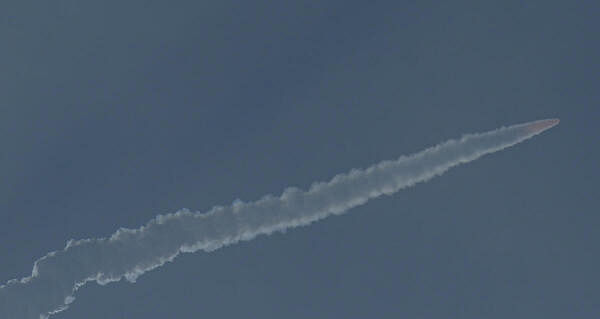
ISRO's Small Satellite Launch Vehicle-03 carrying Earth Observation Satellite (EOS-08) leaves a trail of smoke after it lifted off from the Satish Dhawan Space Centre, in Sriharikota, Andra Pradesh.
Credit: PTI Photo
Chennai: Indian Space Research Organisation (Isro) on Friday successfully launched an earth observation satellite carrying a host of new technology developments in satellite mainframe systems on board a Small Satellite Launch Vehicle (SSLV) from the Satish Dhawan Space Centre in Sriharikota near here.
The smallest SSLV rocket, which measures about 34 metre in height, was launched from the first launch pad at 9:19 am with a one-hour window period. EOS-08, the satellite onboard the rocket, is designed for applications in diverse fields, from soil moisture assessment to disaster management.
The primary objectives of the SSLV-D3-EOS-08 mission are designing and developing a microsatellite, creating payload instruments compatible with the microsatellite bus, and incorporating new technologies required for future operational satellites.
With today's mission, ISRO will complete the developmental flight of the smallest rocket which can carry satellites weighing up to 500 kg and can place them into Low Earth Orbit (of up to 500 km above Earth), giving a boost to NewSpace India Ltd, the commercial arm of ISRO to take up commercial launches using such SSLVs.
The satellite carries three payloads -- Electro Optical Infrared Payload (EOIR), SAC, Global Navigation Satellite System- Reflectometry payload (GNSS-R), SAC and SiC UV Dosimeter, LEOS.
The first payload will take images in Mid-Wave IR (MIR) band and in Long Wave IR (LWIR) band during day and night for various applications like Satellite based surveillance, Disaster Monitoring, Environmental
Monitoring, Fire Detection, Volcanic activities and Industrial and power plant disaster.
The second payload will demonstrate the capability using GNSS-R based remote sensing to derive applications like ocean surface winds, soil moisture, cryosphere applications over Himalayan Region, flood detection, and in-land waterbody detection, while the third payload will monitor the UV irradiance at the view port of the crew module in Gaganyaan Mission.